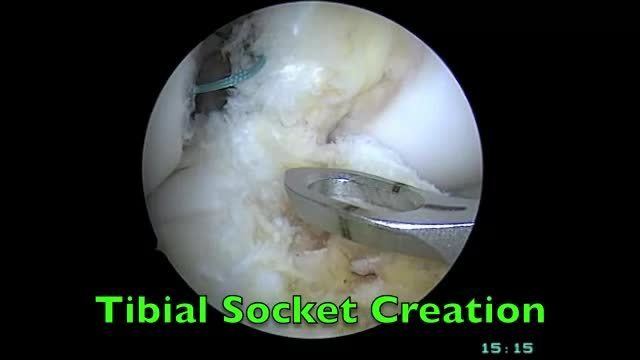 | ||
The Anterior Cruciate Ligament is the ligament that keeps the knee stable. Anterior Cruciate Ligament damage is a very common injury, especially among athletes.Anterior Cruciate Ligament Reconstruction (ACL) surgery is a common intervention. 1 in every 3,000 American suffers from a ruptured ACL and between 100,000 and 300,000 reconstruction surgeries will be performed each year in the United States. Around $500 million health care dollar with come from ACL injuries. ACL injuries can be categorized into groups- contact and non-contact based on the nature of the injury Contact injuries occur when a person or object come into contact with the knee causing the ligament to tear. However, non-contact tears typically occur during the following movements: decelerating, cutting, or landing from a jump. ACL injury is 4-6 times higher in females than in males. An increased Q angle and hormonal differences are a few examples of the gender disparity in ACL tear rates.
Contents
Definition
An anterior cruciate ligament reconstruction with contralateral autogenous patellar tendon graft is a surgical operation involving the harvesting of the patella tendon from the patient's uninjured leg. The graft includes the middle section of the patellar tendon along with two attached bone plugs one on each end.
The contralateral autogenous patellar tendon graft is rarely used as primary revision due to the concern of donor site morbidity. Instead it is primarily considered when a patient is opposed to using an allograft but has already undergone an ACL revision using the ipsilateral patellar tendon. In addition, there are many health care settings around the nation where readily available, safe, and cost effective allograft tissues are not obtainable. In this situation the contralateral autogenous Patellar tendon graft may be the best option
Advantages
Some advantages of the graft include less trauma to the leg that has undergone the ACL revision. Patients regain their range of motion and leg strength on the newly repaired ACL leg much quicker. The graft also allows for a bone-to-bone fixation which allows for more aggressive rehabilitation. The patient also eliminates the chance of any potential complications such as disease transmission that would be present if an allograph was chosen.
Disadvantages
The disadvantages of the graft include infection at this site, anterior knee pain, quadriceps muscle weakness, loss of motion, patella fracture, patellofemoral crepitus, patellar tendonitis, and patellofemoral joint pain. Also, it is not uncommon in certain patient populations to rupture the contralateral ACL following return to their sport. By harvesting the patellar tendon from the opposite knee, the orthopedic surgeon no longer has the option of using that patellar tendon for the reconstruction. It has been noted that a low percentage of patients have suffered a patellar tendon rupture in the first few weeks after surgery due to the increased stress to the area. In addition to a longer operating time the patient will have two scars instead of one.
Rehabilitation
The rehabilitation after the surgery is different for each knee. The beginning rehab for the ACL graft knee is focused on reducing swelling, gaining full range of motion, and stimulating the leg muscles. The goal for the graft donor need is to immediately start high repetition strength training exercises. This will help to regain the lost muscle mass.
In 2007-2009 279 patients underwent primary ACL reconstruction surgery with the use of the contralateral autogenous patellar tendon graft while 58 control patients had the same surgery but with an ipsilateral patellar tendon. Donor Site Recovery When it came comparing the quadriceps muscles to the pre-operative baseline test those who used the contralateral patellar tendon graft had significantly more strength in the ACL reconstruction leg and this held true in the 2 year follow up measurements as well. The study concluded that the use of the contralateral patellar tendon graft does not leave the patient with unresolved donor-site strength loss.
